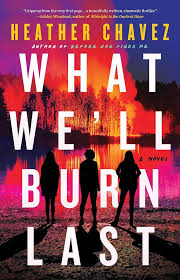As I write this essay at the start of fire season, the skies near me are smoky from a blaze north of where I live. For many residents of wildfire-prone areas, the smell of smoke or strong gusts on a hot day can be triggering. We check our apps or bookmarked links. We text friends and family. Some of us pack go-bags, or record quick videos to document our belongings. For a few months every year, the threat of a wildfire is a physical presence—a visitor unwelcome who nevertheless returns year after year.
When I started drafting What We’ll Burn Last, which involves the search for a missing girl, I knew I wanted it to take place during a wildfire. I went to work on my outline and created the usual character sketches for my three point of view characters—Leyna, her estranged mother Meredith, and neighbor Olivia. But I quickly realized I was missing a crucial POV. Where was the voice of the wildfire? Though without malice, the wildfire is an antagonist in my book, and I realized I needed the fire to be as much a character as the humans who are initially unaware of its approach.
These scenes required extensive research, and though relatively short, they took the most time to write. There was so much pressure to get them right—to capture the ferocity of nature, and to be true to those who’ve survived these disasters and the memory of those who haven’t.
Though challenging, these scenes also rank among my favorite. What We’ll Burn Last couldn’t exist without them. So it is with the unique perspectives included in the six books highlighted below.
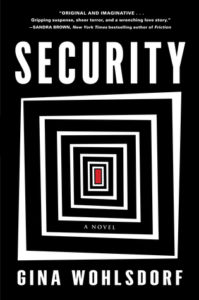
Security, by Gina Wohlsdorf
The exclusive Manderley Resort, set to open on a Santa Barbara beach, promises state-of-the-art security. So the unusual perspective Wohlsdorf uses in Security is fitting: As the staff attends to last-minute details, the action jumps from camera to camera. Outside, the landscape architect tends to the roses. Manager Tessa makes her rounds, checking items off her clipboard as she travels from floor to floor. And a killer washes blood off his hands in Room 717. It’s unclear who (or what) narrates the story, but the cameras capture all, the mundane tasks of the staff juxtaposed with the brutality of the staff being killed one by one. The pages are often divided into two or three columns of text to show action as it occurs simultaneously in different parts of the hotel. The rapid-fire twists keep the adrenaline surging, and the distance of this unusual perspective may have readers shouting at the page—horror movie-style—don’t go in there! Don’t split up! (They don’t listen; they never listen.)

The Last House on Needless Street, by Catriona Ward
As any Google search of xenofiction will show you, there’s an abundance of books with creature POVs. Just a few notable examples: Remarkably Bright Creatures, by Shelby Van Pelt (octopus); Hollow Kingdom, by Kira Jane Buxton (crow); and the story collection The Animal-Lover’s Book Of Beastly Murder, by Patricia Highsmith (a whole slew of creatures in that one). In fact, Three Bags Full author Leonie Swann even wrote on this very topic for CrimeReads. It’s hard to pick just one. Which is why I picked two. The first: The Last House on Needless Street. Not everything is what it seems in Ward’s novel, the unreliable narrators bound together by a terrible secret. One of those narrators is a bible-reading cat, Olivia, who lives with a man named Ted and, occasionally, his daughter Lauren in a dilapidated house at the end of a cul-de-sac. As a cat, Olivia offers a fresh perspective on events, as well as clues to a long-ago tragedy involving a young girl that might escape her human counterparts. Through her eyes, we also gain a more sympathetic portrait of Ted, as all the POVs work together to build dread and tension in a story that may leave readers slightly off-balance in the best way.
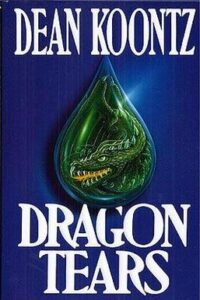
Dragon Tears, by Dean Koontz
After a shooting in a diner, Detective Harry Lyon in Dragon Tears is targeted by a golem who gives him sixteen hours to live. Koontz is the master of creating monsters, human or otherwise, but the emotional core of many of his books is the noble dog. (It’s often a golden retriever; don’t even get me started on my love for Einstein in Watchers, one of my most-loved novels.) So it’s not surprising that in Dragon Tears, stray Woofer gets his own olfactory-centric POV. Koontz brilliantly captures the heart of his canine characters, and their thoughts. (Bad dog. Not true. Good dog. Good. or I would die of lonely. If you know, you know.)

The Lovely Bones, by Alice Sebold
Brutally raped and killed at 14, Susie Salmon narrates The Lovely Bones from the afterlife. Despite the horror of what happened to Susie, it’s not primarily a book about crime. Instead, it’s about how those she left behind—her family, her friends, even her killer—react in the aftermath of her murder. As she watches from her own version of heaven, the perpetually 14 Susie grapples with her own grief and loneliness, longing for a boy and the moments she’ll never have. But she can also be funny, and at times hopeful—a complex character, and an unforgettable perspective.
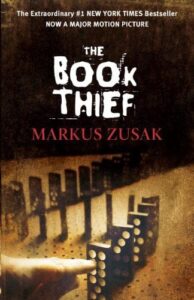
The Book Thief, by Markus Zusak
Set in Nazi Germany, The Book Thief follows a young girl, Liesel Meminger, who is sent to live with foster parents when her brother dies and her mother can no longer care for her. After Liesel finds a copy of The Gravedigger’s Handbook at her brother’s grave, she learns to read, and begins stealing books and sharing them with others, including a Jewish man hidden in her basement. What sets Zusak’s book apart from others covering the horrors of World War II is his unusual choice of narrator: Death. Competent but overworked, sentimental but never nice, Death offers an outsider’s perspective on the brutality of war, the power of words, and what it means to be human.
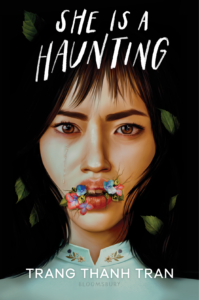
She Is a Haunting, by Trang Thanh Tran
Seventeen-year-old Jade Nguyen and younger sister Lily are spending the summer in Vietnam with father Ba, who she hasn’t forgiven for abandoning her family years before. It is only his promise of paying her college tuition that gets her to the 1920s villa he plans to turn into a bed-and-breakfast. That villa is Nhà Hoa, or “Flower House,” a French colonial where Ba’s mother once lived in the servant’s quarters. But it may not be the new beginning Ba envisions for his family, as Jade begins experiencing paralysis and is haunted by noises within the walls, insects in her food, and the specter of a beautiful ghost-girl from whom she has trouble turning her gaze. The house’s POV sections are titled with body parts, such as the opening chapter, mouth, which begins with these words: The house eats and is eaten. As a living, breathing thing, the house embodies trauma, as well as serving as a representation of the issues of identity and family that Jade struggles with. These scenes are as captivating as they are terrifying.
***


